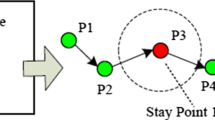Abstract
We develop and test algorithms for assessing the similarity of a person’s days based on location traces recorded from GPS. An accurate similarity measure could be used to find anomalous behavior, to cluster similar days, and to predict future travel. We gathered an average of 46 days of GPS traces from 30 volunteer subjects. Each subject was shown random pairs of days and asked to assess their similarity. We tested eight different similarity algorithms in an effort to accurately reproduce our subjects’ assessments, and our statistical tests found two algorithms that performed better than the rest. We also successfully applied one of our similarity algorithms to clustering days using location traces.
Access this chapter
Tax calculation will be finalised at checkout
Purchases are for personal use only
Preview
Unable to display preview. Download preview PDF.
Similar content being viewed by others
References
Deng, K., et al.: Trajectory Indexing and Retrieval. In: Zheng, Y., Zhou, X. (eds.) Computing with Spatial Trajectories, Springer, New York (2011)
Ma, T.-S.: Real-Time Anomaly Detection for Traveling Individuals. In: Eleventh International ACM SIGACCESS Conference on Computers and Accessibility (ASSETS 2009), Pittsburgh, PA USA, pp. 273–274 (2009)
Patterson, D.J., et al.: Opportunity Knocks: a System to Provide Cognitive Assistance with Transportation Services. In: Mynatt, E.D., Siio, I. (eds.) UbiComp 2004. LNCS, vol. 3205, pp. 433–450. Springer, Heidelberg (2004)
Giroux, S., et al.: Pervasive Behavior Tracking for Cognitive Assistance. In: 1st International Conference on PErvasive Technologies Related to Assistive Environments (PETRA 2008). ACM (2008)
Xiang, T., Gong, S.: Video Behavior Profiling for Anomaly Detection. IEEE Transactions on Pattern Analysis and Machine Intelligence 30(5), 893–908 (2008)
Hastie, T., Tibshirani, R., Friedman, J.: The Elements of Statistical Learning, pp. 520–528. Springer, New York (2009)
United States Bureau of Labor Statistics. American Time Use Survey (ATUS) http://www.bls.gov/tus/
Yi, B.-K., Jagadish, H.V., Faloutsos, C.: Efficient Retrieval of Similar Time Sequences Under Time Warping. In: 14th International Conference on Data Engineering, Orlando, Florida USA, pp. 201–208 (1998)
Levenshtein, V.: Binary Codes Capable of Correcting Deletions, Insertions and Reversals. Soviet Physics Doklady 10(8), 707–710 (1966)
Sinnott, R.W.: Virtues of the Haversine. Sky and Telescope 68(2), 159 (1984)
Kullback, S.: Information Theory and Statistics. Dover, Mineola (1968)
Agrawal, R., Faloutsos, C., Swami, A.: Efficient Similarity Search in Sequence Databases. In: Lomet, D.B. (ed.) FODO 1993. LNCS, vol. 730, pp. 69–84. Springer, Heidelberg (1993)
Holm, S.: A Simple Sequentially Rejective Multiple Test Procedure. Scandinavian Journal of Statistics 6(2), 65–70 (1979)
von Luxburg, U.: A Tutorial on Spectral Clustering. Statistics and Computing 17(4), 395–416 (2007)
Author information
Authors and Affiliations
Editor information
Editors and Affiliations
Rights and permissions
Copyright information
© 2013 Springer-Verlag Berlin Heidelberg
About this paper
Cite this paper
Biagioni, J., Krumm, J. (2013). Days of Our Lives: Assessing Day Similarity from Location Traces. In: Carberry, S., Weibelzahl, S., Micarelli, A., Semeraro, G. (eds) User Modeling, Adaptation, and Personalization. UMAP 2013. Lecture Notes in Computer Science, vol 7899. Springer, Berlin, Heidelberg. https://doi.org/10.1007/978-3-642-38844-6_8
Download citation
DOI: https://doi.org/10.1007/978-3-642-38844-6_8
Publisher Name: Springer, Berlin, Heidelberg
Print ISBN: 978-3-642-38843-9
Online ISBN: 978-3-642-38844-6
eBook Packages: Computer ScienceComputer Science (R0)




